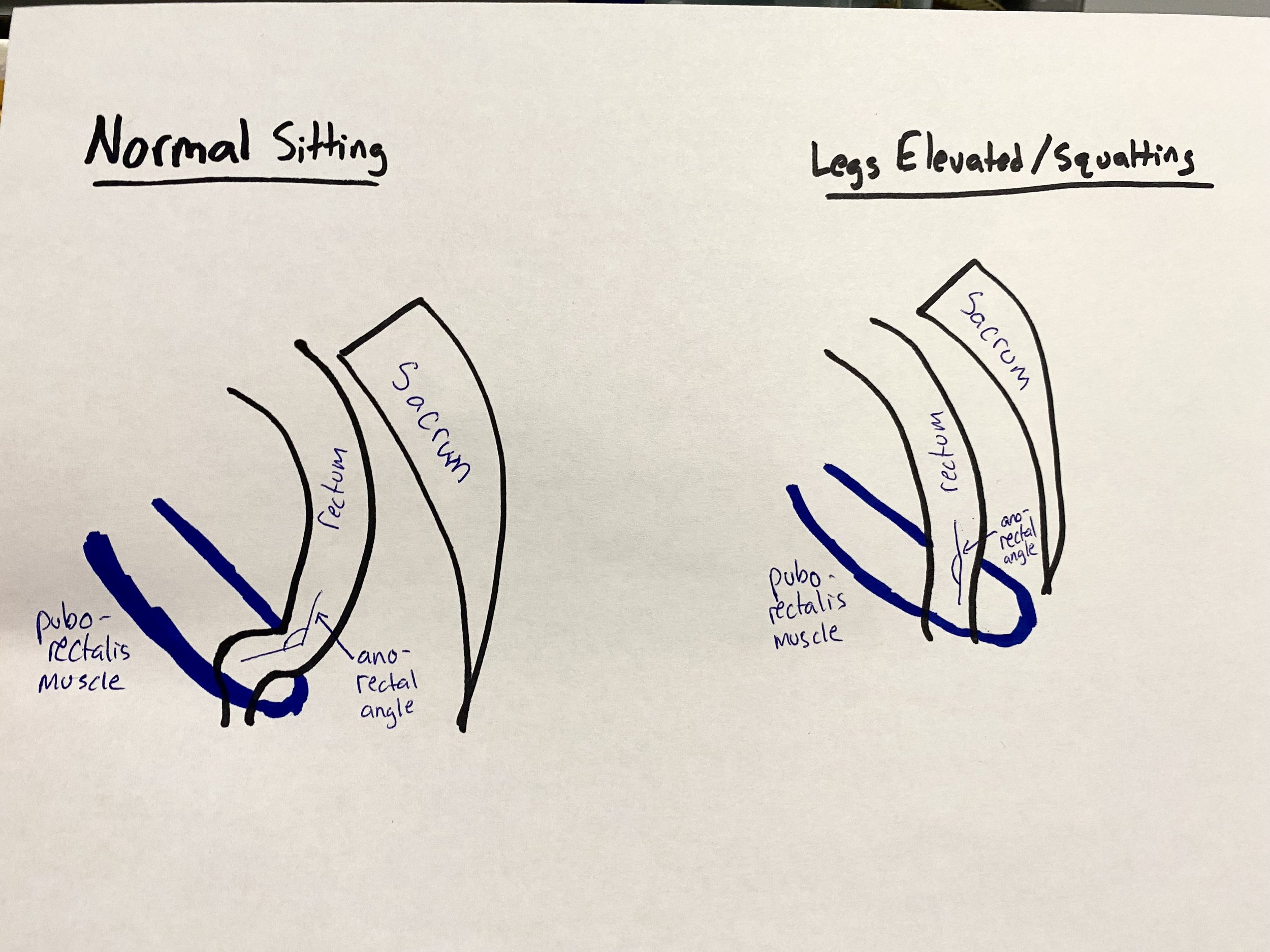The scope of pelvic health physical therapy is wider than you may think. Pelvic physical therapy can help address a variety of gastrointestinal dysfunctions including:
-IBS
-bloating
-fecal incontinence
-abdominophrenic dyssynergia
-and more!
One of the most researched and successfully treated GI dysfunctions in pelvic PT is constipation.
Constipation is broken down into two causes: slow transit, or outlet dysfunction. Slow transit constipation refers to slowed movement of contents through the digestive tract. Outlet dysfunction, which makes up 50% of those with constipation, refers to an issue with the actual elimination mechanism of stool. Outlet dysfunction could be caused by something mechanical like a prolapse pressing on the rectum or the rectum itself prolapsing, or it can be caused by something called pelvic floor dyssynergia. Pelvic floor dyssynergia refers to the paradoxical contraction of the puborectalis (a pelvic floor muscle) during defecation. Ideally for a proper bowel movement, our pelvic floor muscles need to relax to allow stool to pass. Various factors can lead to a pelvic floor contracting rather than relaxing: excessive strain with bowel movements, pain with bowel movements, hypertonicity of pelvic floor muscles, incoordination of internal and external anal sphinter due to chronic constipation, chronic diahrrea, or sphinter injury, etc.
How can Physical Therapy help?
Bowel Mechanics and Muscle Coordination: Research shows increasing hip angle, aka using a Squatty Potty or stool to elevate your legs, improves the anorectal angle and relaxes the puborectalis muscle to allow for improved bowel elimination. Education on positioning and training on proper relaxation of pelvic floor muscles will help restore proper body mechanics while eliminating. A retraining of proper voiding intervals, i.e. not delaying a bowel movement when you experience the urge can help improve coordination between internal and external sphincters.
Manual Therapy: Performing a colon massage and being taught a self colon massage can help improve transit speed through the digestive tract as well as decrease bloating. Additionally, manual techniques to address individualized tension that may reside in the abdomen (think restricted tissue from c-section scar, or previous surgery, etc) or pelvic floor muscles (think restricted tissue from tearing during delivery or chronic tension) can help release any restriction preventing the movement or elimination of stool.
Breathing Techniques: Proper breathing, and avoiding strain, while on the toilet can help improve the muscle coordination and relaxation required for a proper bowel movement. Breathing is effective in calming resting pelvic floor tension that may be contributing to some people’s constipation. A study by Clinical Gastroenterology and Hepatology found breathing exercises to decrease symptoms of bloating by 55%.
Strengthening: Increasing deep abdominal strength in those with deficits could help improve intra-abdominal pressure required to eliminate. Pelvic floor strengthening may be needed for those with constipation due to prolapse. As much as 95% of those with pelvic organ prolapse report constipation, so addressing prolapse with physical therapy will help improve constipation.
Diet and Lifestyle Education: Guidance on fluid intake and fiber intake can have an impact on your constipation and will be discussed by a physical therapist. Improving general activity is helpful in speeding up digestive transit and a physical therapist can help create an individualized exercise program for you including specific exercises to improve abdominal blood flow.
There are instances where constipation may not be related to any physical or mechanical issue and is more medically involved. Even if this is the case, physical therapy can help provide you techniques for at least relieving some of the uncomfortable symptoms associated with constipation.
At our Boulder Physical Therapy practice we have pelvic health physical therapy that can help address constipation as well as other gastrointestinal issues.
Schedule an appointment with a pelvic health specialist today!
Susan E. George, Diane F. Borello-France, Perspective on Physical Therapist Management of Functional Constipation, Physical Therapy, Volume 97, Issue 4, April 2017, Pages 478–493,
Binford, Joyce PT Physical Therapy Management of Outlet Dysfunction Constipation and Pelvic Pain, Journal of Women’s Health Physical Therapy: May/August 2013 – Volume 37 – Issue 2 – p 59-69
Olszewski, Rose Marie DPT Case Report of a Postpartum Patient With Vestibulodynia, Dyspareunia, Constipation, and Stress Urinary Incontinence, Journal of Women’s Health Physical Therapy: January/April 2012 – Volume 36 – Issue 1 – p 20-34
Bannister, Tami MSPT Physical Therapy Management of Pelvic Floor Dyssynergia, Journal of Women’s Health Physical Therapy: Winter 2009 – Volume 33 – Issue 3 – p 16-21


